Get in touch
Thanks for getting in touch
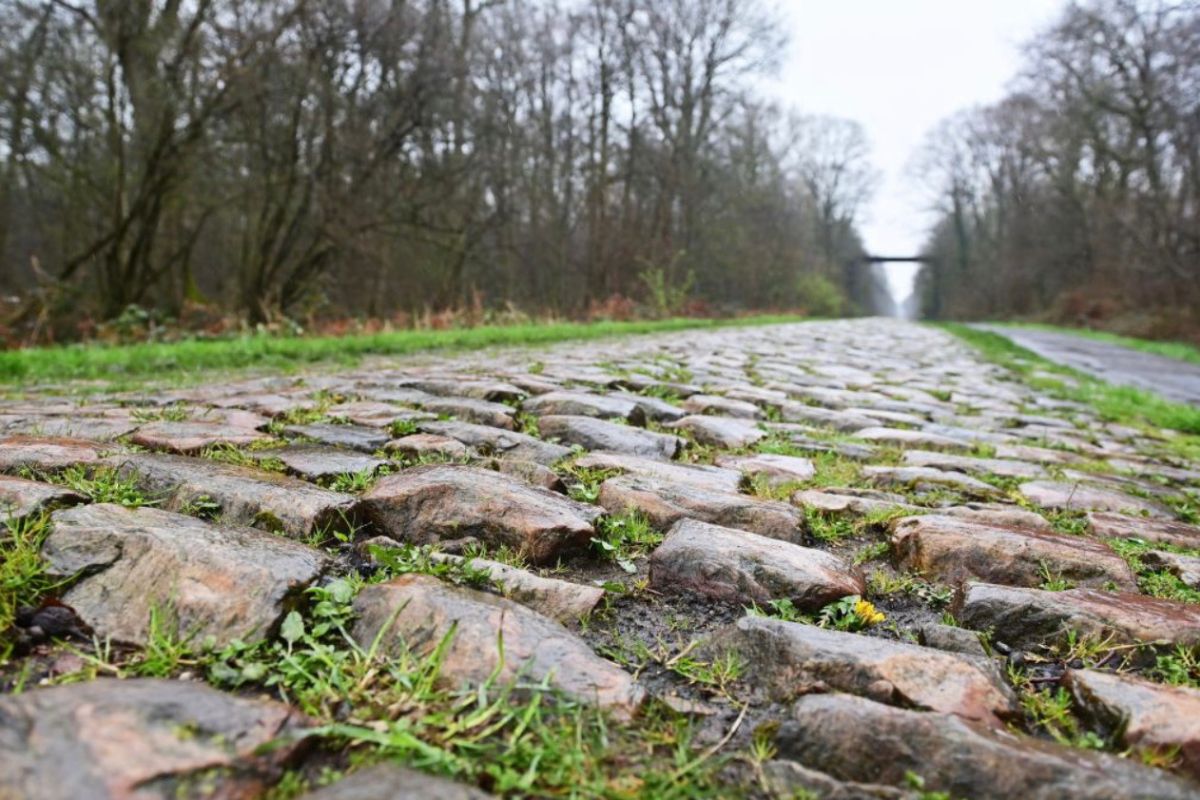
The Paradox of the Pavè
What!
This can’t be right.
The alarm breaks my sleep, it seems just as I’m dozing off to sleep.
I’ve only just closed my eyes.
I check my watch.
Yep, its right . . . 2.50am
I’m up for a large bowl of porridge, a sweet coffee and a ham and cheese baguette . . . as you do.
Then a 15-minute cycle to a meet point, followed by a 2-hour 30 minutes coach journey, the equivalent of London to Birmingham, full of middle aged men in Lycra (or Mamil’s) farting off their early morning breakfast.
Everybody looks the same, nervous, excited, worried, questioning themselves.
Why?
The Pavè.
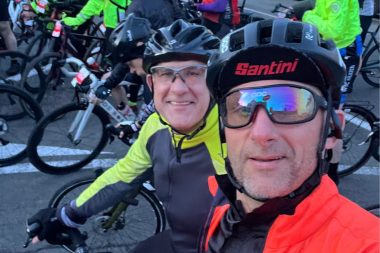
Me and my hero – My brother Dave
Last Thursday I set off with my brother Dave to Northern France to tackle the Paris Roubaix for the second time.
Named the ‘Queen of the Classics’, the Paris Roubaix is the 3rd of 5 monument one day races in the pro cycling calendar, it is said to be the toughest single day race and the one that most professional riders would rather win than a stage of the illustrious Tour de France.
Its unofficial title – the ‘Hell of the North’,
Why?
The cobbles (or Pavè, to give them their correct name)
The best way to describe it is to quote former American professional cyclist Chris Horner who described them like this — “they ploughed a dirt road, flew over it with a helicopter, and then just dropped a bunch of rocks out of the helicopter. That’s Paris–Roubaix. It’s that bad. It’s ridiculous”
Theo de Rooij, a Dutchman, had been in a promising position to win the 1985 edition of the race but then crashed, losing his chance of winning.
Covered in mud, he offered his thoughts on the race to a reporter after the crash:
“It’s a bollocks, this race!”. “You’re working like an animal, you don’t have time to piss, you wet your pants. You’re riding in mud like this, you’re slipping … it’s a pile of shit.”
When then asked if he would start the race again, de Rooij replied:
“Sure, it’s the most beautiful race in the world!”
A huge smile appears across his face, and he bursts out laughing uncontrollably.
It’s my favourite sporting quote, it resonates, I understand him.
That’s why I love it.
Each year amateur cyclists are given the chance to ride the route 1 day ahead of the professional men, the women’s race is run on the same day as we ride, meaning we have to be off the course before they catch us, adding to the pressure of the day.
Indeed, when you get to the start line there is a huge sign that reads ‘Welcome to Hell’ reminding you of the impending suffering that awaits.
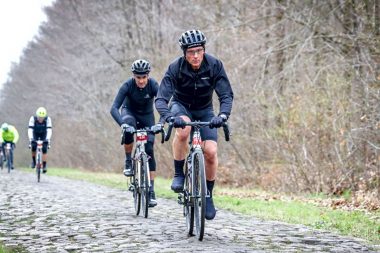
Head fixed on the end point – cycling the Arenberg Trench
What is it like to ride the pave?
They are like nothing else.
Why?
Well for a start they hurt, all 29 sections of them.
Quoted as being 10 x worse than another road surface currently ridden on the pro tour.
Each section is between 1-3 km and are graded from 1-5 in difficulty, with 1 being the easiest and 5 the toughest. They are graded by length, technical requirements and how rough the sections are.
There are 4 x Grade 4 sections and 3 x Grade 5 sections – The Carrefour de l’Arbre – Mons-en Pévèle – and the worst of them all, The Arenberg Trench
Although in truth, they all bloody hurt.
This is my best description of them all:
1) The Vibration – First to hit you is the force of the vibrations, it’s brutal
Your arms shake violently to a point where holding on is a challenge in itself.
Over hand grip on the cross section of the handlebars is preferred by many, fingers wrapped around the front of the handlebars and thumbs around the back giving a complete 360 grip. Without this your hand being shaken off the bars is a real risk and you hit the deck.
But there’s a problem to this, you can’t access the brakes from here on modern bikes – which they say is a good thing as any braking on the cobbles will surely result in your hitting the deck – hard.
2) The Visibility – Visibility is poor due to the vibrations, you can’t look down because everything is a blur, and you can’t look up due to the mud and dust. You just need to look ahead to find the best line, which is usually centre of the track.
3) The Camber – most of the tracks have a camber – a raised ridge in the middle dropping downwards out each side, so the best line is definitely on the top of the camber, the problem, everyone wants this line. If you find the central line, you hold it, don’t give it up, if people want to pass, let them pass either side of you but don’t give up your line.
Drop onto the sloped sides and you risk the bike skidding from under you.
Some brave few ride the gutters either side of the road, but these have lots of crash inducing potholes, often filled with water so you don’t see them coming, the first you know is when you somersault over your handlebars.
Stay in the middle and to hell with everyone else.
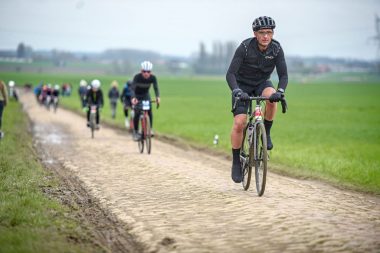
Hold that central line Foz!
4) The Mud – these are basically agricultural farm tracks so there is mud everywhere. If it is wet, the mud is treacherous, so avoid, if dry, it can help slightly by smoothing the cobbles on the crown a little, but you still take a chance. Whatever the conditions, the mud or dust is everywhere.
5) The Corners – it’s enough to ride on straight section of pave but throw in. 90º turn and it’s a bloody nightmare, slow down and just pray you come out upright, That’s it, just pray, to a god, any god, just pray.
4) The Body – your back isn’t built for cobbled riding, your lower back can feel the vibrations directly through S1, L4 L5 – anyone with lower back issues will be familiar with these troublesome little buggers. Your neck hurts from craning all the time to see ahead and to steer the best line. 10 days after the ride and I’m still feeling the ride in my body.
5) The Thermal Effect – all the vibrations create an amazing warming effect on the body, if you have lots of layers on to protect from the cold, wet and wind, you can easily overheat on the pave sections. The serios riders have a saying, ‘be bold start cold”, but with a 7.00am start in Northern France you take a chance, and as I get older, I don’t like being cold, so I wear layers.
6) The Hands – Blisters on the hands often set in from before the halfway mark, roughly at the Arenberg Trench, once they start, it’s a losing battle, they only get worse. Tape them up and suck it up. I am fortunate as a lifter of weights in the gym my hands condition well and blisters are rare, but office workers hands like my softer older brother, often suffer the most. I love the pain he endures, it’s payback for the years he beat me up whist growing up. I love him, obviously, he knows that, but I love him to suffer more than me, it’s a sibling thing.
I offer support, by constantly reminding him of his weakness, often using ‘Blackadder’ quotes where appropriate.
“You’re a Jotter blotter, a pen pusher, come on Captain Darling”.
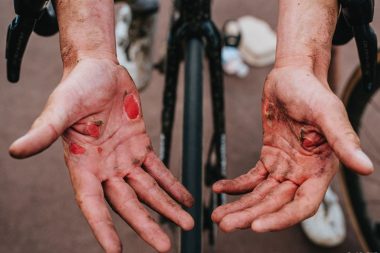
Blisters are commonplace on the Paris-Roubaix – They receive little sympathy though.
It is tough on the hands, fingers need stretching out after each section of pavè because they are sore from the intense gripping, forearms and biceps too need extending to stretch off. Riders can be seen on mass shaking their hands out in turn after each section.
7) The weather – this is a constant variable but has a significant impact on risk assessment. Riders pray for dry conditions, even if its windy, cyclists hate riding into a headwind, but this is better than the wet. Wet roads are fine, wet cobbles are horrific, there are even apps that predict weather for the Roubaix updating conditions hourly it’s that significant.
I’ve been lucky riding the Roubaix twice in dry conditions, however I have ridden them in the rain twice in practice rides. Average speed is doubled under these conditions, so pray for dry.
That’s it really, nothing more to add, other than after the first section, there are 28 more over 174km/108miles.
Why write about it like this, because there is something about it unlike anything else I have ever done.
Just like the mud and dirt, the whole event gets into your skin.
The finish of the race enters the famous velodrome in Roubaix and after riders cross the line, they then get the chance to wash the dirt, grime, and dust of northern France’s farmland out of their hair, skin, nose, and eyes in Roubaix’s historic communal showers.
It’s part of the race.
It’s tradition.
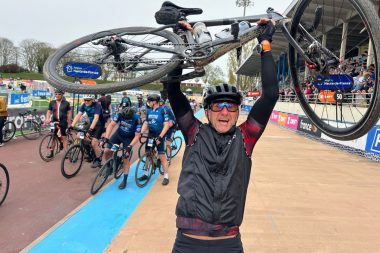
The traditional bike aloft pose after crossing the finish line in Roubaix’s famous Velodrome.
Paris-Roubaix is strange even by cycling standards.
It’s held over 19th-century roads raced with 21st-century bikes.
Cycling, like life, hurtles forward, but remains moored to its past.
A sport steeped in tradition, the showers in Roubaix’s outdoor velodrome are a throwback to how cycling used to be.
That’s why I love the Paris Roubaix
It’s been often said that there is a fine line between love and hate.
So it is with joy and suffering.
Human psychology is interesting, and I find it more and more fascinating the older I get (although not wiser it’s fair to add).
I don’t think I am a masochist, (although quite possibly denial is the first clue of evening such a character)
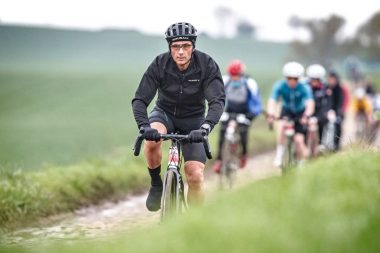
In a field of cyclists but very much on my own.
I don’t ride to suffer, but it seems as if it’s the passage to the feelings of joy, satisfaction, happiness, and ecstasy, increased in intensity when paired with struggle, stress, pain and suffering.
Love and hate.
The beauty of the Pave
It encapsulates love and hate.
The pain and suffering coupled with joy and celebration.
The paradox is profound.
Each bone-rattling section of pavé adds an element of unpredictability to the ride, testing the riders’ ability to maintain control and momentum amidst the chaos.
As a goalsetting coach I often talk about process related goals vs outcome related goals,
If we can add enjoyment to the actions required to progress towards an outcome it all becomes easier as a result, enjoying the journey as we travel.
I always where possible try to embrace and enjoy the process, but the Paris Roubaix is different.
The internal battle between enjoying the process, even when it is as brutal as the 29 sections of Pavè versus looking forward to ending it as soon as possible with the outcome goal, completion, in one piece.
It’s a constant battle, embrace and enjoy the brutal ride, or enjoy each section being crossed off the list each time one is completed, or both.
The meaning
This all sounds a bit Yin and Yang I know, (the complementary forces that interact to form a dynamic system in which the whole is greater than the assembled parts), but there is a reason for this almost obsessional love for the dusty tracks of Northern France.
It’s the fundamental basics of the meaning of life.
Life is tough, at times, in varying degrees for everyone.
But it’s also beautiful.
The meaning to life for me is simple, I can sum up in 6 words.
‘Purpose from the passing of time’
That’s the easy bit.
What’s purpose?
Purpose – the reason for which something is done or exists.
That’s where it becomes trickier and indeed has a personal objectivity to it.
For me purpose is have the courage to keep stepping out of my comfort zone, into action, and having the resilience to see it through to the end of the goals I have set.
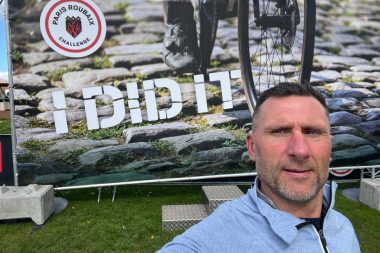
Post race photo, still can’t raise a smile.
It about living life with a forward centre of mass, not back on my heels.
It’s about having the courage to take action on a given target, and the resilience to see it through.
It’s not about Boxsets on Netflix
It’s been 2 weeks to the day since I rode
Last night my brother Dave sent me a text at 10.05pm
“I ❤️ paris roubaix……it is cycling’s pinnacle”
I replied.
“I can’t tell you how much I fucking love it
It gets in my veins
I love it more every day after I come home from it
He added
“Until you do it, it is very difficult to explain”
I added
“You can’t, I say to people it cannot be described only experienced to understand, and still then you don’t understand”
Will I be back next year?
In the words or de Rooij
“Sure, it’s the most beautiful race in the world!”
Paris Roubaix Sportive runs every year in April